
By Spencer Lachman
Collaborative Forestry Management Apprentice
Degraded conditions within the forests and meadows of the northern Sierra Nevada pose complex challenges to land managers looking to prioritize ecosystem health. Historically, these ecosystems were controlled by natural disturbances, but human intervention has changed the severity and frequency of these events. In ecology a disturbance is any action or event which changes the structure and function of an ecosystem. Disturbances exist on a spectrum of severity, extent, and time and can be natural or human caused. 17 Fire and flooding shaped the montane ecosystems of the northern Sierra Nevada but changing land use practices and a warming climate have altered the dynamics of ecological disturbance in our region. 4, 15

Meadow complexes and nearby riparian areas are some of the most productive ecosystems in the northern Sierra Nevada. They also serve as desirable grazelands because meadow grasses are high quality forage for livestock. Balancing the need to restore and maintain diverse ecological communities with the need to use resources to sustain human livelihoods is a challenge for land managers throughout the region. Photo credit Ryan Burnett of PointBlue Conservation Science
Changes to natural disturbance regimes jeopardize forests and watersheds and threaten human livelihoods. Severe and unpredictable wildfire behavior not only puts homes and forests at risk, but strains the healthcare systems of smoke-impacted areas. 2 Drought exaggerates these conditions by drying soils and woody fuels, and increasing the variability of precipitation which would otherwise regulate aridity and fire severity. In the near future California will face more frequent hotter-droughts and the northern Sierra Nevada will likely experience declines in annual snowpack volume. 12, 15 Communities throughout the state and the montane water sources which support them will become vulnerable as ecological and human needs for water compete over limited resources.

Dense understory fuels in a stand of mixed conifer forest at the Green Island Lake project. Prescribed fire is currently being planned for the project area. 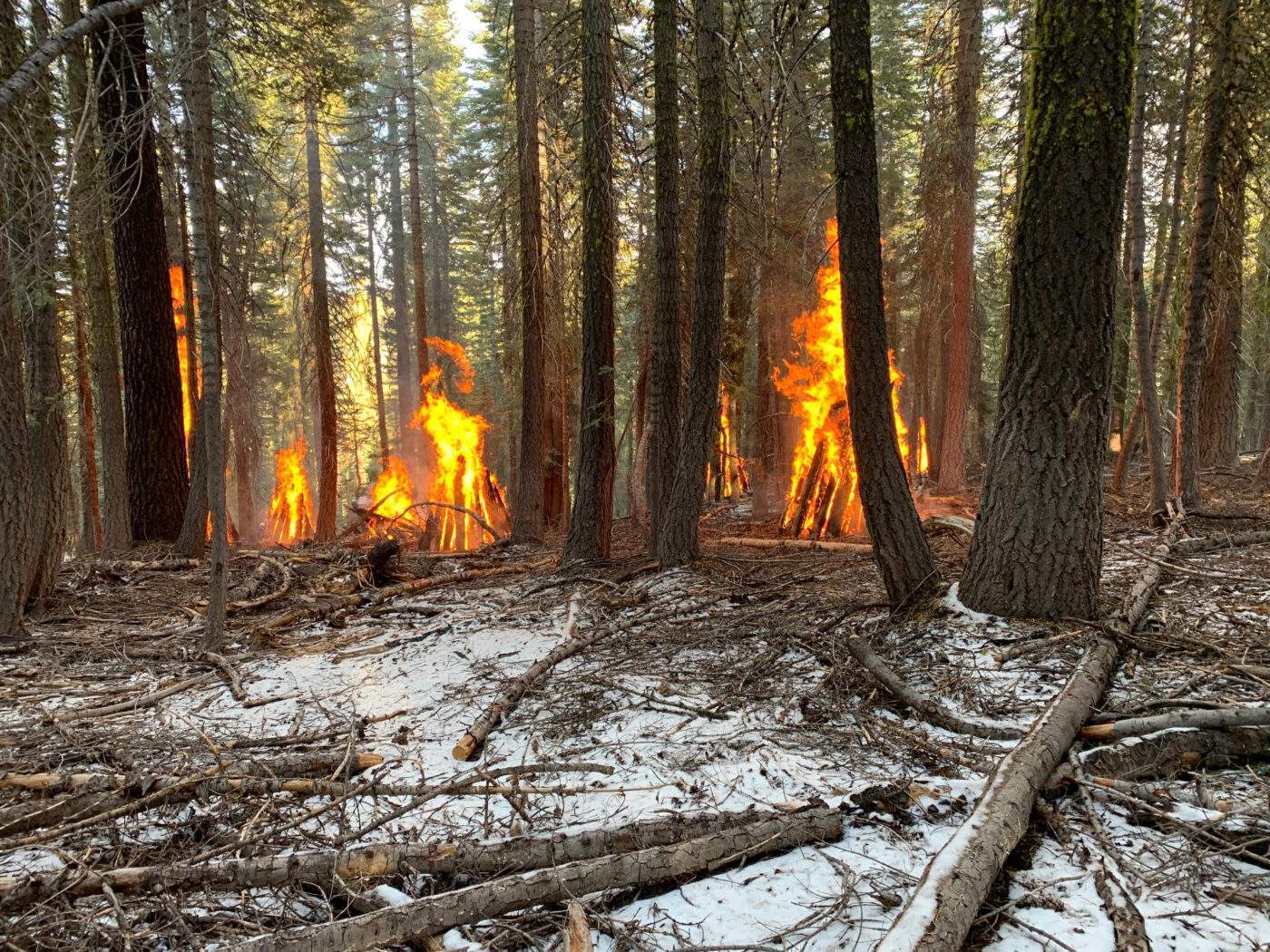
Pile burning in progress, Nov. 2020, at Flatiron Ridge.
The future may appear daunting, but land managers are capable of reducing these risks and improving landscape-scale resilience through ecological restoration. Restoration aims to reestablish processes that allow an ecosystem to function similarly to an analogous, undisturbed site. Restoration begins by assessing current conditions to identify causes of degradation and methods for reversing them. This involves restoring the roles of soil and water, rehabilitating plant and animal communities, and carefully monitoring the effectiveness of restoration treatments.17 By focusing on processes and not simply attributes, land managers can use natural disturbances and variability in ecosystems to maintain healthy landscapes which support ecological integrity and human needs.
Because human uses of natural resources are diverse, the values guiding their management often conflict. To resolve conflict in natural resource management stakeholders and land managers collaborate when designing restoration projects. Collaboration is a structured process which facilitates the accomplishment of a common purpose by sharing knowledge, resources, and increasing collective capacity. 16
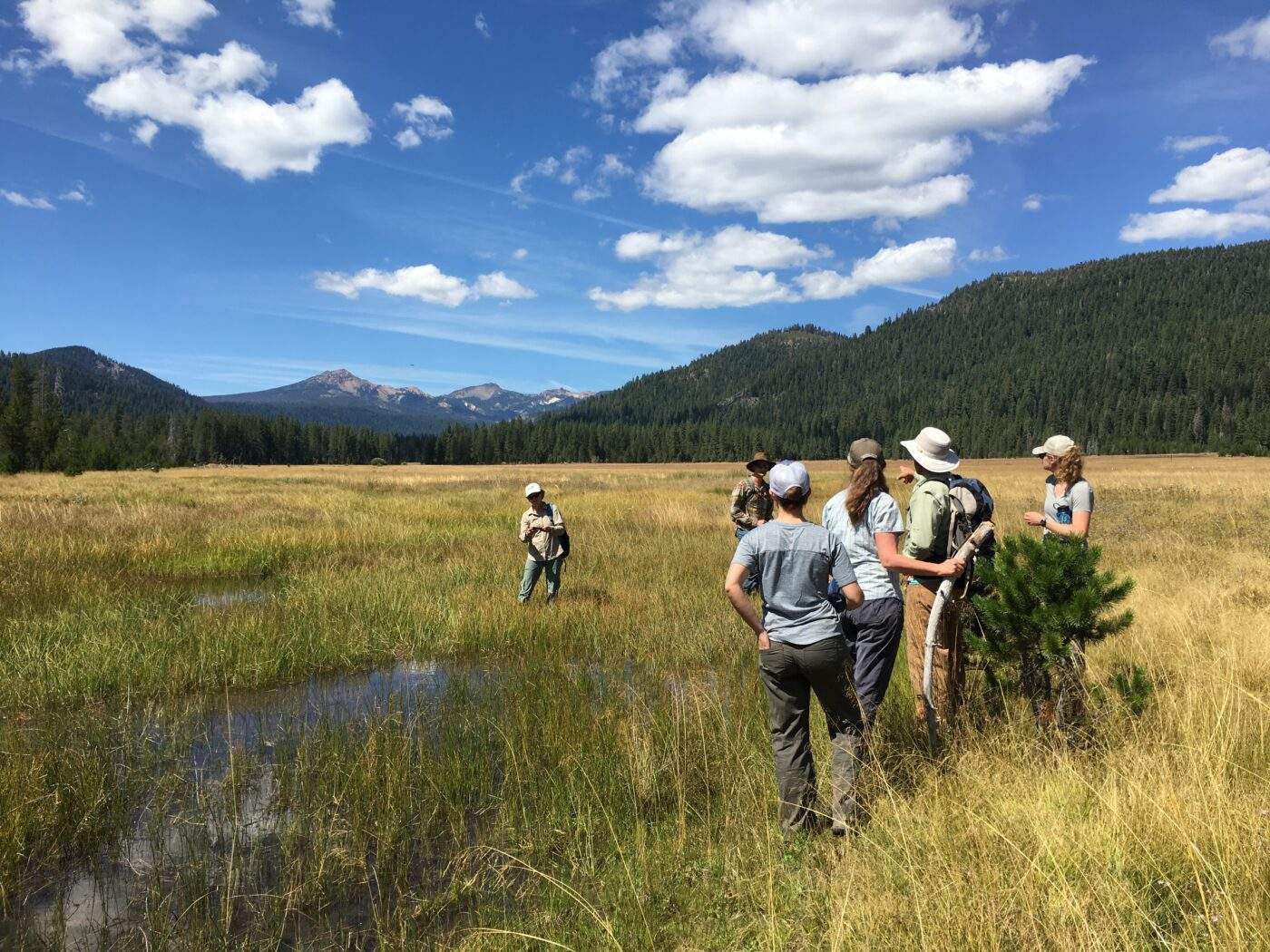
Collaborators discuss wetland function and restoration opportunities on a site visit to Childs Meadow. Photo credit Sierra Institute.
Collaboration can improve the efficiency of restoration by distributing the responsibilities of project planning, implementation, and outreach. Collaboration offers a formal channel for the representation of public values and a means of accomplishing cross-boundary work between partners. In the northern Sierra Nevada collaboration is being used by the South Lassen Watersheds Group (SLWG) to proactively manage forests and restore hydrologic function to vulnerable ecosystems. The SLWG is a collaborative facilitating restoration within the Upper Feather River watershed by engaging non-profit, tribal, federal, private, and public interests in the collective pursuit of resilient forests, safe communities, and clear, connected waterways.
The SLWG is implementing landscape scale restoration by concurrently treating crowded forests and dysfunctional meadow systems. Improving forest health in Sierran mixed – conifer forests requires the careful reintroduction of fire as a disturbance process capable of maintaining diverse habitat and forest composition. 4, 8 Down woody fuels have become abundant in the absence of fire, and small fir trees have crowded the understory. These shaded trees compete for limited sunlight and water, leaving many unhealthy and vulnerable to attack by bark beetles and fungal pathogens.14 Dense fir stands have also made vertical forest structure more continuous as saplings overlap with the low branches of taller trees. Forest survival is threatened by these conditions because flames can easily spread from these ladder fuels into the crowns of larger, living trees where crown fire will burn throughout the canopy. 8, 13

Conifer encroachment and incised, unstable banks are two of the most common forms of stream channel degradation in the northern Sierra Nevada. This reach of Colby Creek is afflicted by both – highlighting the urgent need for restoration to restore and maintain sensitive riparian habitat. Photo credit Ryan Burnett, PointBlue Conservation Science.
When drought, high temperatures, and dense fuels converge the resulting fire can be deadly and unyielding. Recent wildfires fueled by wind events channeled through the steep Feather River Canyon came dangerously close to communities on Lake Almanor’s western shore. In response, the SLWG and the LNF planned the West Shore Community Wildfire Protection Project (WSP) to strategically reduce fuels, improve recreation opportunities, and reintroduce fire as a disturbance process across multiple ownerships covering more than five thousand acres.
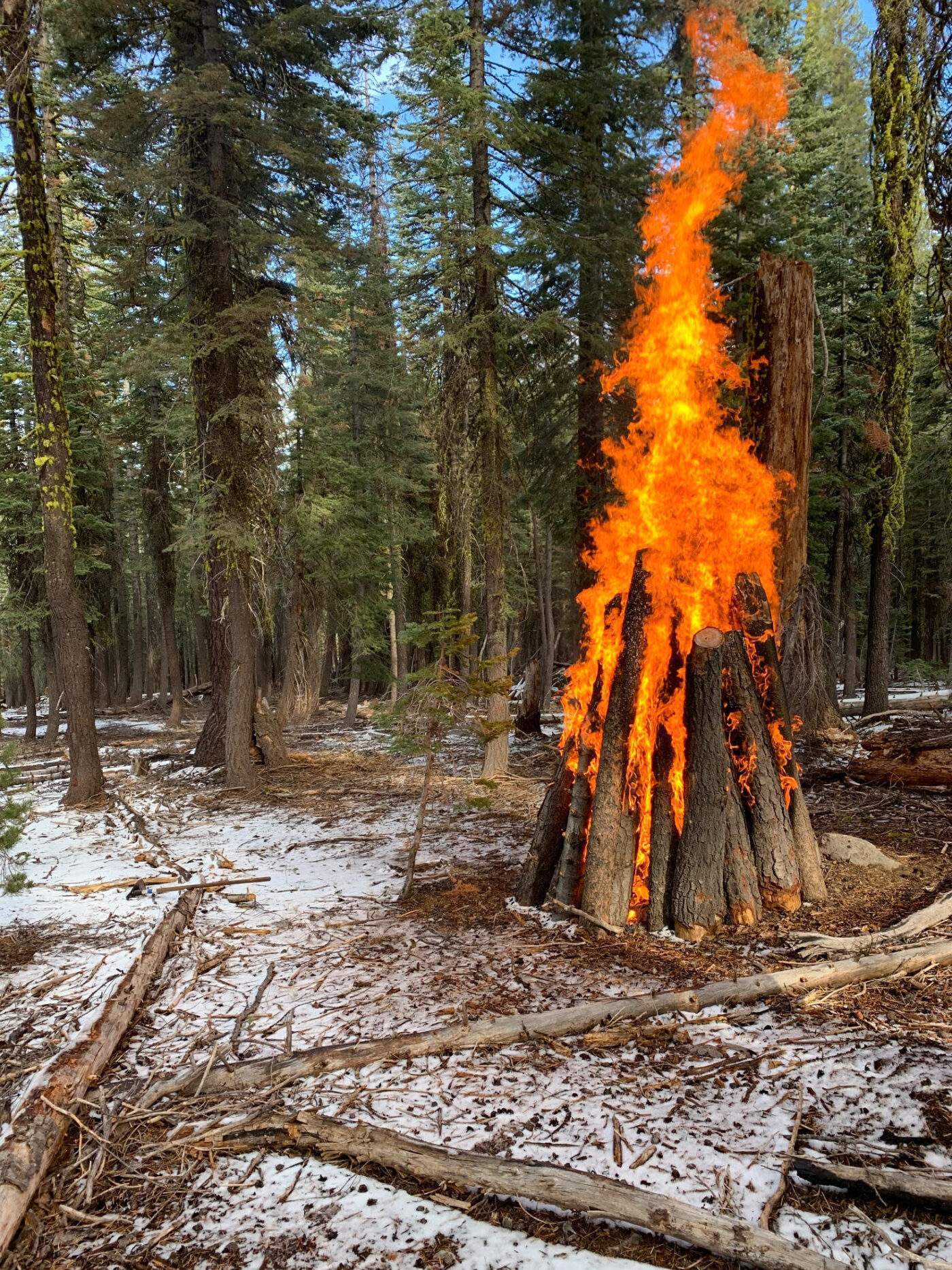
A pile burn from November 2020 on Flatiron Ridge. The burning of these piles was an essential element of the North Fork Feather River Headwaters Forest Restoration Project . Photo credit Steve Buckley, Lassen Volcanic National Park.
There is consensus among land managers that fire should be used to restore diversity in the structure of forests because it can create open spaces which function as fire breaks while promoting diversity in grass and shrub communities. 1, 4, 8 The goal is to re-create conditions that allow for frequent low-severity fire but woody fuels on the WSP are dense, requiring manual and mechanical reduction to prepare the project area before it can safely burn. Managers select for specific sizes and species of trees when thinning and intentionally create diverse stands which will have variable responses to fire. Even treated landscapes have variation in the type and density of fuel, moisture, and topography and these factors collectively influence fire effects and post-burn conditions. 3, 7
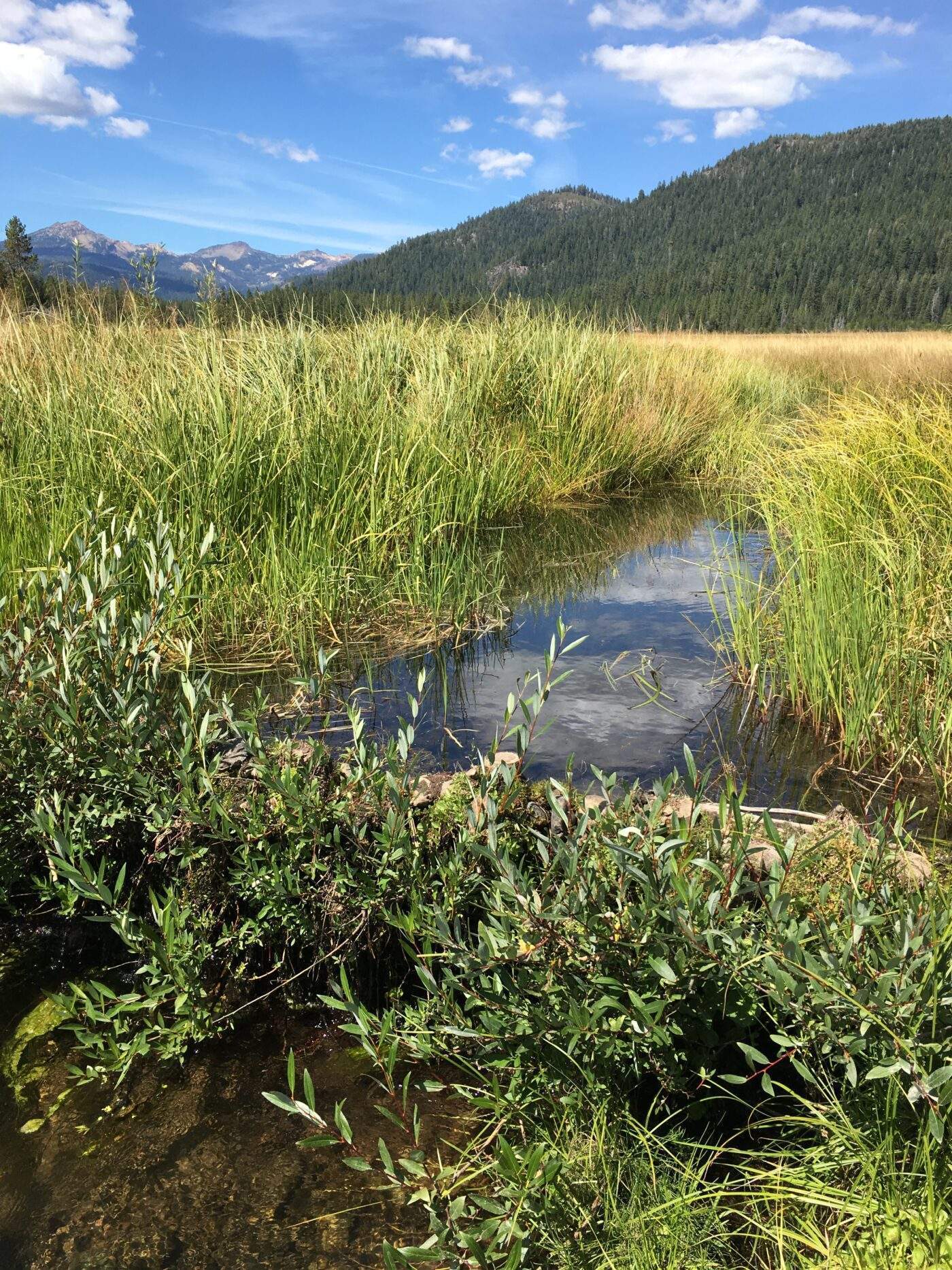
A beaver dam analog in action in Childs Meadow. Photo credit Sierra Institute.
Controlling the severity and intensity of wildfire can also mitigate changes to montane hydrology. When shrub and tree cover is lost snowmelt is not moderated by shaded forests and snowpack can melt quickly. Large volumes of surface runoff can cause rapid erosion which deposits substantial quantities of sediments and nutrients into waterways — damaging meadow complexes and impairing human water sources.6 The SLWG is addressing climate-vulnerable headwater hydrology by applying a climate-smart approach to meadow and stream restoration. Restoring hydrologic function to watersheds while accounting for the uncertainty of climate change must address the ecosystems ability to experience disturbance while retaining key qualities and functions. 18
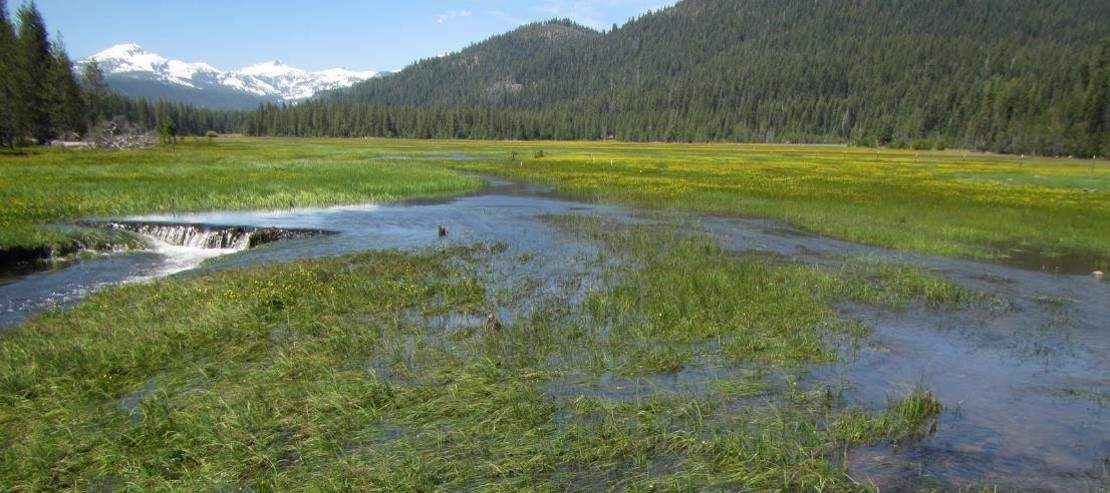
A critically important function of meadow complexes are their ability to slow the force of floods and spread water across an entire flood plain. At Childs Meadow, beaver-dam analogs have been installed in the stream channel to facilitate flooding and the deposition of sediments within the floodplain. Photo credit Sarah Yarnell
Watersheds in northeastern California historically generated some of the deepest snowpack in the state, but their relatively low elevation means they are especially vulnerable to changes in temperature and the timing of precipitation. Irregular weather patterns may increase the frequency of disturbances like drought and flood so watersheds must be capable of responding to either while meeting human and ecological needs for water. 11, 15
The meadow complexes of the northern Sierras and southern Cascades are vital to sustaining montane hydrology because critical meadow functions regulate water movement and quality. Meadows slow the flow of water and deeply saturate the surrounding soils, mitigating low flow conditions and reducing the force of floods. 6, 12 However, many of these unique ecosystems are critically impaired. Past and current land uses have degraded the condition of meadows leaving many streams deeply incised and hydrologically disconnected from the surrounding ecosystem. 5, 9,, 18

A critically important function of meadow complexes are their ability to slow the force of floods and spread water across an entire flood plain. At Childs Meadow, beaver-dam analogs have been installed in the stream channel to facilitate flooding and the deposition of sediments within the floodplain. Photo credit Ryan Burnett, PointBlue Conservation Science.
The SLWG is assessing vulnerable meadow functions to guide implementation of adaptable restoration practices capable of succeeding under different climate scenarios. At Childs Meadow, a restored meadow complex just south of Lassen National Park, partners from PointBlue Conservation Science and the Collins Pine Company prioritized resilience by restoring channel structure and flood dynamics which allow meadows to self-regulate water movement.
Addressing greater variability in the timing and volume of flows requires meadows to be highly connected both across and beneath the floodplain.10, 12, 18 Eroded channels can be filled with cobbles or gravel which slow the movement of water and facilitate flooding. These plugs push flood waters out of the stream channel and onto the floodplain where they spread out over a large area — dispersing erosive forces, depositing sediments, and re-establishing channel-floodplain connectivity. 5, 18

Staff from the Sierra Institute and Lassen Volcanic National Park plant propagated manzanita in the Summit Lake campground. The camping areas have become highly impacted by human use and in many areas lack vegetation completely. Planting native vegetation like manzanita improves the appearance of the campground for visitors and rehabilitates soil. Photo credit Sierra Institute.
A connected floodplain and high water table also improves habitat for plant species which thrive in a wet environment, further stabilizing banks and developing alluvial soils. Water is retained in the meadow systems after flood events by the construction of beaver dam analogs, woody structures built within the stream channel that act as small dams. These dams reduce the flow of water out of the meadow system and work in concert with gravel plugs to create narrow, meandering, heavily vegetated channels separated by slow, deep pools and riffles. 14 These restored waterways provide cold, clear, and connected riparian habitat and preserve meadow function through periods of drought. 9, 10, 18
By recognizing the vulnerability of our landscapes and communities the SLWG is helping people restore more than forest health or flood control. Collaboration and the inclusion of local perspectives restores the relationships between ecosystems and people, fostering a culture of adaptive management and stewardship as the connections between forest health and community well-being are made clear. The SLWG continues to foster climate – conscious, adaptable communities by engaging local capacity in restoration activities and planning for future challenges to regional well-being.
LITERATURE CITED
- Barth, M. A., A. J. Larson, and J. A. Lutz. 2015. A forest reconstruction model to assess changes to Sierra Nevada mixed-conifer forest during the fire suppression era. Forest Ecology and Management 354:104-118.
- Black, C., Y. Tesfaigzi, J. A. Bassein, and L. A. Miller. 2017. Wildfire smoke exposure and human health: Significant gaps in research for a growing public health issue. Environmental toxicology and pharmacology 55:186-195.
- Casady, G. M., W. J. van Leeuwen, and S. E. Marsh. 2010. Evaluating post-wildfire vegetation regeneration as a response to multiple environmental determinants. Environmental modeling & assessment 15:295-307.
- Cohen, J. 2008. The wildland-urban interface fire problem: A consequence of the fire exclusion paradigm. Forest History Today.Fall: 20-26. :20-26.
- Gonzalez, B., D. Kieffer, C. Kingsley, B. Stambuk-Torres, E. Szeto, and J. Natali. 2019. Case Study: Pond and Plug Restoration at the Perazzo Meadows in the Northern Sierra Nevadas. :.
- Kattelman, R., M. Embury. Riparian areas and wetlands. Sierra Nevada Ecosystem Project, Final Report to Congress; 1996.
- Lentile, L. B., P. Morgan, A. T. Hudak, M. J. Bobbitt, S. A. Lewis, A. M. Smith, and P. R. Robichaud. 2007. Post-fire burn severity and vegetation response following eight large wildfires across the western United States. Fire Ecology 3:91-108.
- Mallek, C., H. Safford, J. Viers, and J. Miller. 2013. Modern departures in fire severity and area vary by forest type, Sierra Nevada and southern Cascades, California, USA. Ecosphere 4:1-28.
- Patterson, L., and D. J. Cooper. 2007. The use of hydrologic and ecological indicators for the restoration of drainage ditches and water diversions in a mountain fen, Cascade Range, California. Wetlands 27:290-304.
- Roni, P., T. J. Beechie, R. E. Bilby, F. E. Leonetti, M. M. Pollock, and G. R. Pess. 2002. A review of stream restoration techniques and a hierarchical strategy for prioritizing restoration in Pacific Northwest watersheds. North American Journal of Fisheries Management 22:1-20.
- Null, S. E., J. H. Viers, and J. F. Mount. 2010. Hydrologic response and watershed sensitivity to climate warming in California’s Sierra Nevada. PLoS One 5:e9932.
- Slocombe, M. L., and J. D. Davis. 2014. Morphology of small, discontinuous montane meadow streams in the Sierra Nevada. Geomorphology 219:103-113.
- Stephens, S. L., J. T. Stevens, B. M. Collins, R. A. York, and J. M. Lydersen. 2018. Historical and modern landscape forest structure in fir (Abies)-dominated mixed conifer forests in the northern Sierra Nevada, USA. Fire Ecology 14:1-14.
- Stephenson, N. L., A. J. Das, N. J. Ampersee, B. M. Bulaon, and J. L. Yee. 2019. Which trees die during drought? The key role of insect host‐tree selection. Journal of Ecology 107:2383-2401.
- Ullrich, P. A., Z. Xu, A. M. Rhoades, M. D. Dettinger, J. F. Mount, A. D. Jones, and P. Vahmani. 2018. California’s drought of the future: A midcentury recreation of the exceptional conditions of 2012–2017. Earth’s future 6:1568-1587.
- Urgenson, L. S., C. M. Ryan, C. B. Halpern, J. D. Bakker, R. T. Belote, J. F. Franklin, R. D. Haugo, C. R. Nelson, and A. E. Waltz. 2017. Visions of restoration in fire-adapted forest landscapes: lessons from the Collaborative Forest Landscape Restoration Program. Environmental management 59:338-353.
- Vaughn, K. J., Porensky, L. M., Wilkerson, M. L., Balachowski, J., Peffer, E., Riginos, C. & Young, T. P. (2010) Restoration Ecology. Nature Education Knowledge 3(10):66
- Vernon, M. E., B. R. Campos, and R. D. Burnett. 2019. A guide to climate-smart meadow restoration in the Sierra Nevada and southern Cascades. Point Blue Contribution.

